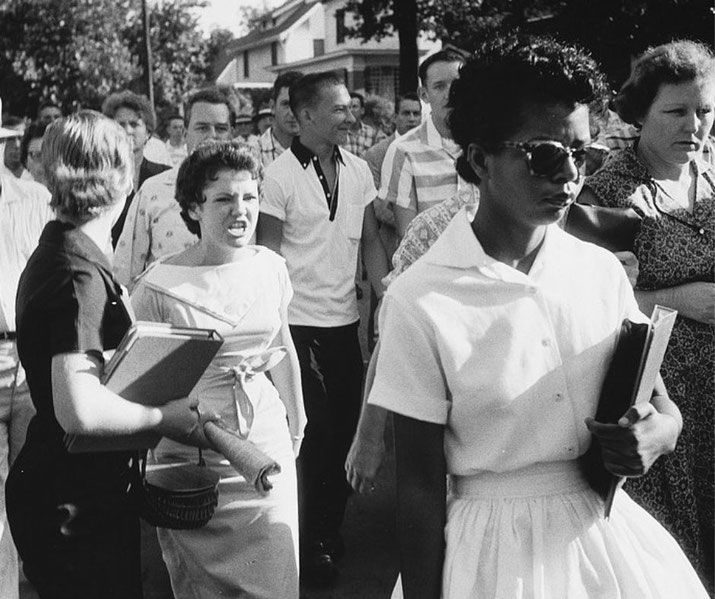The Little Rock Nine: How children became the centre of the civil rights struggle

In 1957, nine Black students were brave enough to attend a previously all-white school in Little Rock, Arkansas.
These students, known as the Little Rock Nine, were faced with abuse and violence from both the white community and the school administration.
The Little Rock Nine's story is one of courage and determination in the face of adversity.
Racism in American schools
The history of school segregation in the United States is a long and complicated one.
Segregation in schools was made legal by the Plessy v. Ferguson Supreme Court case in 1896, which ruled that "separate but equal" facilities were constitutional.
While the original ruling was specifically about segregated train cars, it provided a justification for racial separation in many other areas, including education.
In particular, it allowed states to pass laws mandating segregated schools, and many did so.
In the South, schools were segregated by race, with white students attending one set of schools and Black students attending another.
However, the reality was that the separate facilities for Black students were usually inferior to those for white students.
This was especially true in the South, where funding for black schools was often inadequate.
The situation in Little Rock before desegregation was one of tension and conflict. The black community had been working for years to end segregation in the city's schools.
On May 17, 1954, the US Supreme Court ruled that segregation in public schools was unconstitutional.
This ruling, known as Brown v. Board of Education, mandated that schools be integrated "with all deliberate speed".
While the Little Rock Central High School board pledged to desegregate the school voluntarily, it was three years before the first Black students entered.
Who were the nine children?
In 1957, nine children were chosen to integrate Little Rock Central High School. They were Ernest Green, Elizabeth Eckford, Jefferson Thomas, Terrence Roberts, Carlotta Walls, Minnijean Brown, Gloria Ray Karlmark, Thelma Mothershed, and Melba Pattillo.
These students were chosen because they had good grades and were well-behaved.
They were also considered to be 'test cases' for integration; that is, their success or failure would be used to determine whether or not other schools should be integrated.
The Little Rock Nine were prepared for their first day at the new school by a number of people and organizations. First, they met with their parents to discuss what to expect.
Then, they attended a workshop on dealing with racism. At the workshop, they learned how to deal with hostile classmates and adults.
Finally, they met with the NAACP (National Association for the Advancement of Colored People) legal team, who advised them on their rights and what to do if they were arrested.
In particular, Daisy Bates, who was the president of the Arkansas chapter of the NAACP, began mentoring the Little Rock Nine in preparation for the upcoming struggles.
First day of school
The night before the teens were to face their first day at the school, Arkansas governor, Orval Faubus, ordered 270 soldiers from the state's National Guard troops to stand at the front door of the school.
Faubus claimed that their presence was to prevent violence amid rumors of potential unrest, but in reality, they were ordered to prevent the nine children from entering the buildings.
When the nine students arrived at the school on the 4th of September 1957, they were met with a hostile crowd of white students and adults.
The mob shouted racial slurs and threats at the children.

Some of the white students tried to physically block the Black students from entering the school.
While eight of the nine Black students had arrived together, 15-year-old Elizabeth Eckford had arrived by herself and faced the abuse alone.
Regardless, the National Guard stopped all of the nine African American students from entering the building and they were forced to go home.
They were not able to enter the school for more than two weeks.
The president intervenes
On the 14th of September, Governor Faubus was asked to meet with President Dwight Eisenhower to resolve the situation.
However, it appeared to make little difference. Six days later, a federal court issued an injunction against Faubus, declaring that he had used the Arkansas National Guard unlawfully and ordered him to stop using the National Guard to block the students' entry.
This finally led the governor to remove the National Guard from the school.
This created the opportunity for the nine students to attempt to attend the school again.
So, on September 23rd, the Little Rock Nine managed to enter the high school.
However, they did not finish the day. Rioting occurred outside the school and the students were subjected to abuse inside.
They were spat on, pushed downstairs, and had garbage thrown at them.
Consequently, the Little Rock police arrived at the school and removed the nine students for their own safety.
So, President Eisenhower decided that he had to intervene once more to guarantee the safety of the teenagers.
On the 24th of September, the President ordered 1200 soldiers from the US Army’s 101st Airborne Division to travel to Little Rock.
Then, on the 25th of September, these soldiers acted as the personal bodyguard of the nine students and escorted them to and from classes.
As a result, the Little Rock Nine were able to complete their first full day of school.

The first year of school
While the soldiers were commissioned to walk with the students between classes, they were not allowed to stay in the classroom with them.
This meant that the Little Rock Nine were still subjected to a lot of abuse from their fellow students.
Then, the 101st Airborne left in November 1957. By that stage, President Eisenhower had issued Executive Order 10730, which federalized the Arkansas National Guard.
So, when the 101st Airborne departed, the president sent in the Arkansas National Guard to protect the children.
The rest of their year at school was not an easy one for the black children. They constantly received death threats and there were even attempted bombings of their homes.
One of the students, Minnijean Brown, was suspended and then expelled in the middle of the school year.
The reason given was that she had poured a cup of chili on the head of a boy who had been harassing her.
The other students also continued to face racism and discrimination.
Despite the difficulties of the year, the nine students managed to complete their year of study in May 1958.
In fact, on May 27, 1958, Ernest Green became the first Black student to graduate from Little Rock Central High School.
The 'lost year' of 1958-59
The integration of Little Rock Central High School by the Little Rock Nine in 1957 was met with fierce resistance by many white residents and politicians, including Arkansas Governor Orval Faubus.
Despite his defiance of federal law, Faubus won reelection as governor in 1958, largely due to his segregationist stance, which appealed to many white voters in Arkansas.
Even though there had been a successful integration with the help of federal troops, tensions in the community remained high.
The fact that Little Rock crisis was covered extensively by national and international media increased the pressure that decision makers felt to defend their decisions.
So, in an attempt to block further integration, the Little Rock School Board, under pressure from the state legislature and Governor Faubus, voted to close all four of Little Rock's public high schools for the entire 1958-1959 school year.
This decision affected more than 3,600 students.
The closure had a profound impact on both black and white students in Little Rock. Many students missed a full year of education, leading to long-term academic and professional setbacks.
Some white families were able to send their children to hastily organized private schools, known as "segregation academies", but these were often substandard.
In comparison, Black students generally had fewer alternatives. Some moved to other districts or even out of state to continue their education, but many simply missed the entire year.
Overall, the closure created a sense of chaos and uncertainty in the community and deepened racial divisions.
How the school was reopened
The decision to close the schools led to legal battles. A group of local mothers, both black and white, known as the "Women's Emergency Committee to Open Our Schools" (WEC), played a key role in challenging the closure and advocating for the reopening of the schools.
After a year of closure, the schools were reopened for the 1959-1960 school year.
However, the legacy of the Lost Year lingered, with ongoing challenges to integration and educational disparities between black and white students.
The next few years were relatively calm compared to the first year. By 1960, many of the white students had begun to accept the presence of African American students in the school.
The long-term effects
Although the Little Rock Nine were able to integrate Little Rock Central High School, their story remained challenging.
The experience took a toll on all of them, both mentally and physically. Some of them even required therapy to deal with what they had been through.
In addition, many of their families also suffered numerous acts of aggression and attacks, including vandalism and death threats.
For example, on February 9, 1960, a bomb was detonated at the family home of Carlotta Walls, one of the Little Rock Nine.
Carlotta, her mother, and her sisters were at home. Fortunately, no one was injured, but the blast caused significant damage to the house, including removing bricks and breaking windows.
Despite ever-present threats like this, the Little Rock Nine are still considered heroes.
They paved the way for other African American students to have equal access to education.
In addition, they also proved that desegregation could be peacefully achieved if there was enough support from the government.
What do you need help with?
Download ready-to-use digital learning resources
Copyright © History Skills 2014-2025.
Contact via email
With the exception of links to external sites, some historical sources and extracts from specific publications, all content on this website is copyrighted by History Skills. This content may not be copied, republished or redistributed without written permission from the website creator. Please use the Contact page to obtain relevant permission.





